Taylor D.A. Introduction to marine engineering
Подождите немного. Документ загружается.

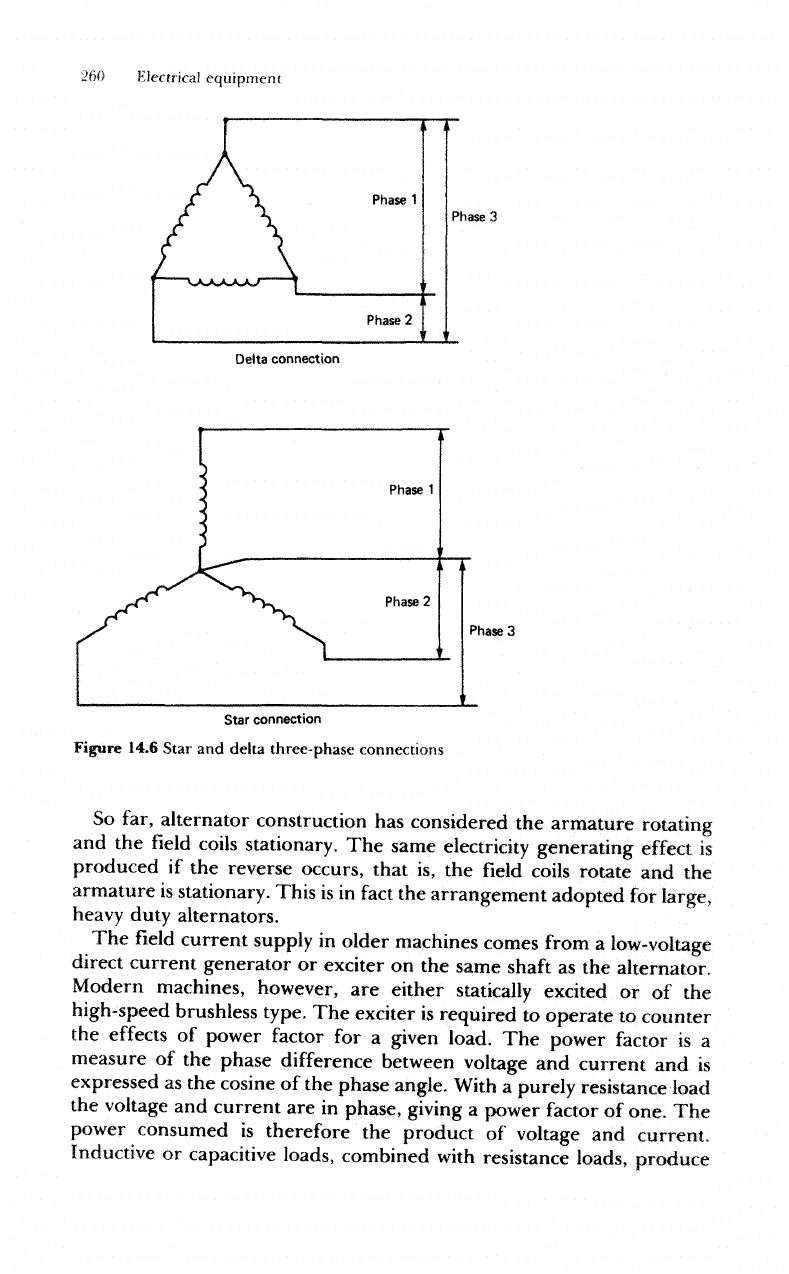
260
Electrical equipment
Phase
3
Delta
connection
Phase3
Star
connection
Figure
14.6
Star
and
delta
three-phase
connections
So
far, alternator construction
has
considered
the
armature rotating
and the field
coils
stationary.
The
same electricity generating
effect
is
produced
if the
reverse occurs, that
is, the field
coils rotate
and the
armature
is
stationary. This
is in
fact
the
arrangement adopted
for
large,
heavy
duty alternators.
The field
current supply
in
older machines comes from
a
low-voltage
direct current generator
or
exciter
on the
same
shaft
as the
alternator.
Modern machines, however,
are
either statically excited
or of the
high-speed
brushless type.
The
exciter
is
required
to
operate
to
counter
the
effects
of
power factor
for a
given load.
The
power factor
is a
measure
of the
phase difference between voltage
and
current
and is
expressed
as the
cosine
of the
phase angle. With
a
purely resistance
load
the
voltage
and
current
are in
phase, giving
a
power factor
of
one.
The
power
consumed
is
therefore
the
product
of
voltage
and
current.
Inductive
or
capacitive
loads, combined
with
resistance loads, produce
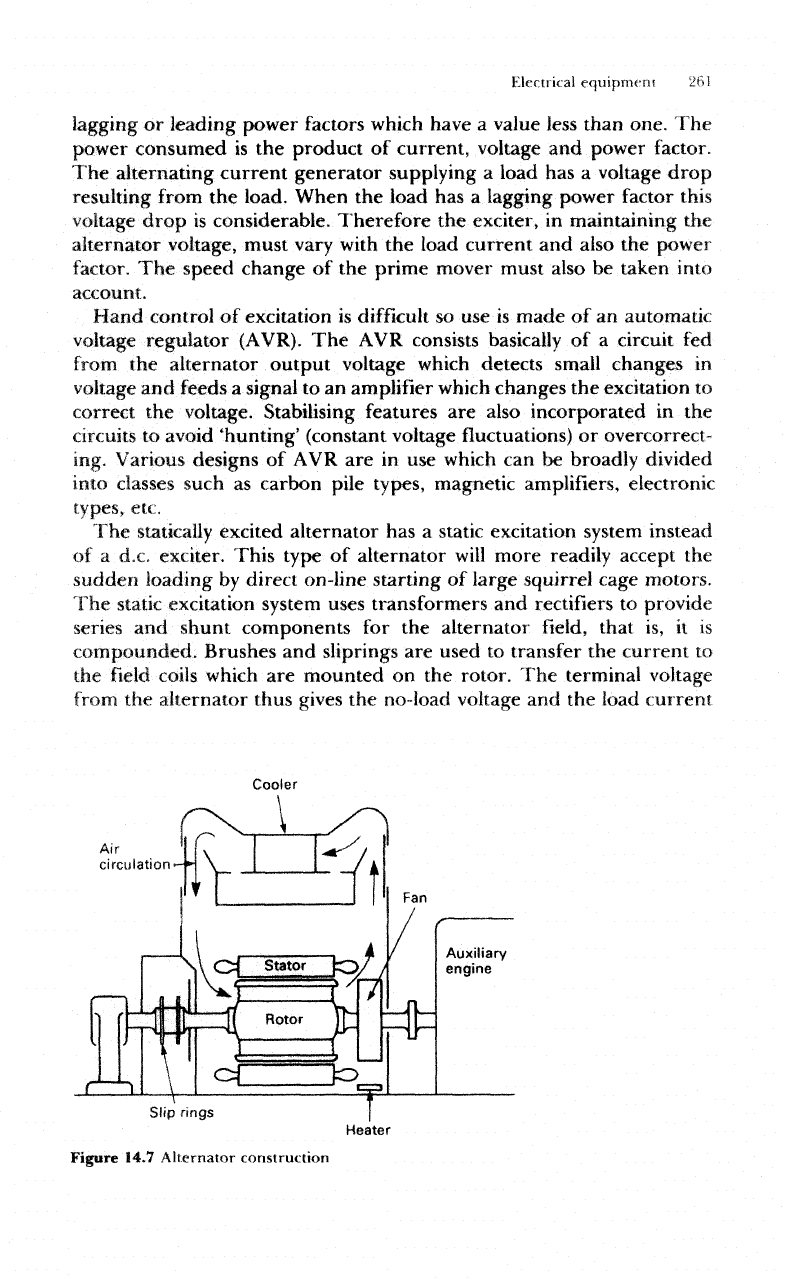
Electrical
equipment
261
lagging
or
leading
power factors which have
a
value less than one.
The
power
consumed
is the
product
of
current, voltage
and
power factor.
The
alternating current generator supplying
a
load
has a
voltage
drop
resulting from
the
load.
When
the
load
has a
lagging power factor this
voltage
drop
is
considerable. Therefore
the
exciter,
in
maintaining
the
alternator voltage, must vary with
the
load current
and
also
the
power
factor.
The
speed change
of the
prime mover must also
be
taken into
account.
Hand
control
of
excitation
is
difficult
so use is
made
of an
automatic
voltage
regulator
(AVR).
The AVR
consists basically
of a
circuit
fed
from
the
alternator output voltage
which
detects small changes
in
voltage
and
feeds
a
signal
to an
amplifier which changes
the
excitation
to
correct
the
voltage. Stabilising features
are
also incorporated
in the
circuits
to
avoid
'hunting'
(constant voltage
fluctuations) or
overcorrect-
ing.
Various designs
of AVR are in use
which
can be
broadly divided
into classes such
as
carbon pile types, magnetic amplifiers, electronic
types, etc,
The
statically excited alternator
has a
static excitation system instead
of
a
d.c. exciter. This type
of
alternator
will
more readily accept
the
sudden loading
by
direct on-line starting
of
large
squirrel
cage
motors.
The
static
excitation system uses transformers
and
rectifiers
to
provide
series
and
shunt components
for the
alternator
field,
that
is, it is
compounded.
Brushes
and
sliprings
are
used
to
transfer
the
current
to
the
field
coils
which
are
mounted
on the
rotor.
The
terminal voltage
from
the
alternator thus
gives
the
no-load voltage
arid
the
load
current
Cooler
Air
circulation
Slip
rings
Figure
14.7 Alternator construction
Heater
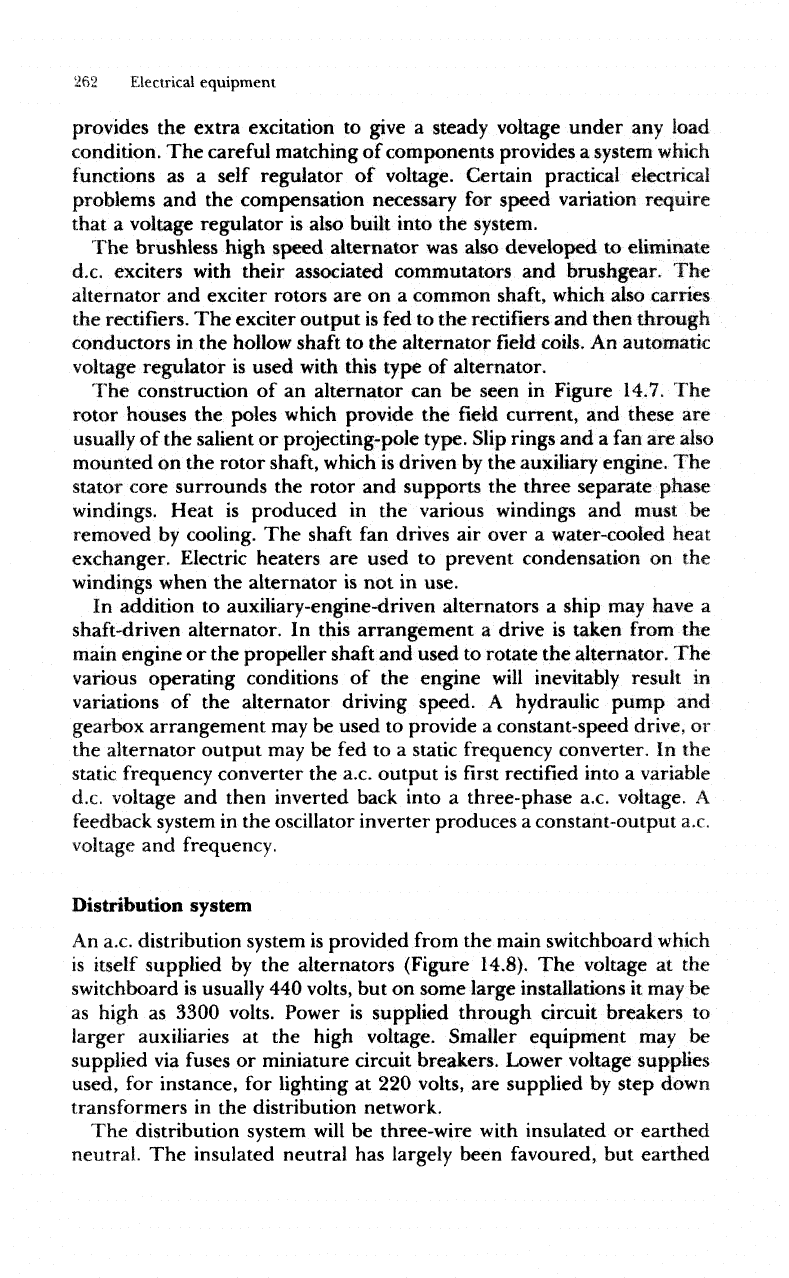
262
Electrical equipment
provides
the
extra excitation
to
give
a
steady voltage under
any
load
condition.
The
careful matching
of
components provides
a
system
which
functions
as a
self regulator
of
voltage. Certain practical electrical
problems
and the
compensation necessary
for
speed variation require
that
a
voltage regulator
is
also built into
the
system.
The
brushless high
speed
alternator
was
also
developed
to
eliminate
d.c. exciters
with
their associated commutators
and
brushgear.
The
alternator
and
exciter rotors
are on a
common
shaft,
which
also
carries
the
rectifiers.
The
exciter output
is fed to the
rectifiers
and
then through
conductors
in the
hollow
shaft
to the
alternator
field
coils.
An
automatic
voltage
regulator
is
used
with
this type
of
alternator.
The
construction
of an
alternator
can be
seen
in
Figure 14.7.
The
rotor
houses
the
poles
which
provide
the field
current,
and
these
are
usually
of the
salient
or
projecting-pole
type. Slip rings
and a fan are
also
mounted
on the
rotor
shaft,
which
is
driven
by the
auxiliary engine.
The
stator core surrounds
the
rotor
and
supports
the
three
separate phase
windings.
Heat
is
produced
in the
various windings
and
must
be
removed
by
cooling.
The
shaft
fan
drives
air
over
a
water-cooled heat
exchanger. Electric heaters
are
used
to
prevent condensation
on the
windings
when
the
alternator
is not in
use.
In
addition
to
auxiliary-engine-driven alternators
a
ship
may
have
a
shaft-driven
alternator.
In
this
arrangement
a
drive
is
taken
from
the
main
engine
or the
propeller
shaft
and
used
to
rotate
the
alternator.
The
various
operating conditions
of the
engine
will
inevitably
result
in
variations
of the
alternator driving speed.
A
hydraulic
pump
and
gearbox arrangement
may be
used
to
provide
a
constant-speed drive,
or
the
alternator
output
may be fed to a
static frequency converter.
In the
static
frequency
converter
the
a.c. output
is first
rectified into
a
variable
d.c. voltage
and
then inverted back into
a
three-phase a.c. voltage.
A
feedback
system
in the
oscillator
inverter produces
a
constant-output a.c,
voltage
and
frequency.
Distribution system
An
a.c. distribution
system
is
provided
from
the
main switchboard
which
is
itself
supplied
by the
alternators
(Figure
14.8).
The
voltage
at the
switchboard
is
usually
440
volts,
but on
some large
installations
it may be
as
high
as
3300 volts. Power
is
supplied through circuit
breakers
to
larger
auxiliaries
at the
high voltage. Smaller equipment
may be
supplied
via
fuses
or
miniature circuit breakers. Lower
voltage
supplies
used,
for
instance,
for
lighting
at 220
volts,
are
supplied
by
step down
transformers
in the
distribution network.
The
distribution system
will
be
three-wire
with
insulated
or
earthed
neutral.
The
insulated
neutral
has
largely been favoured,
but
earthed
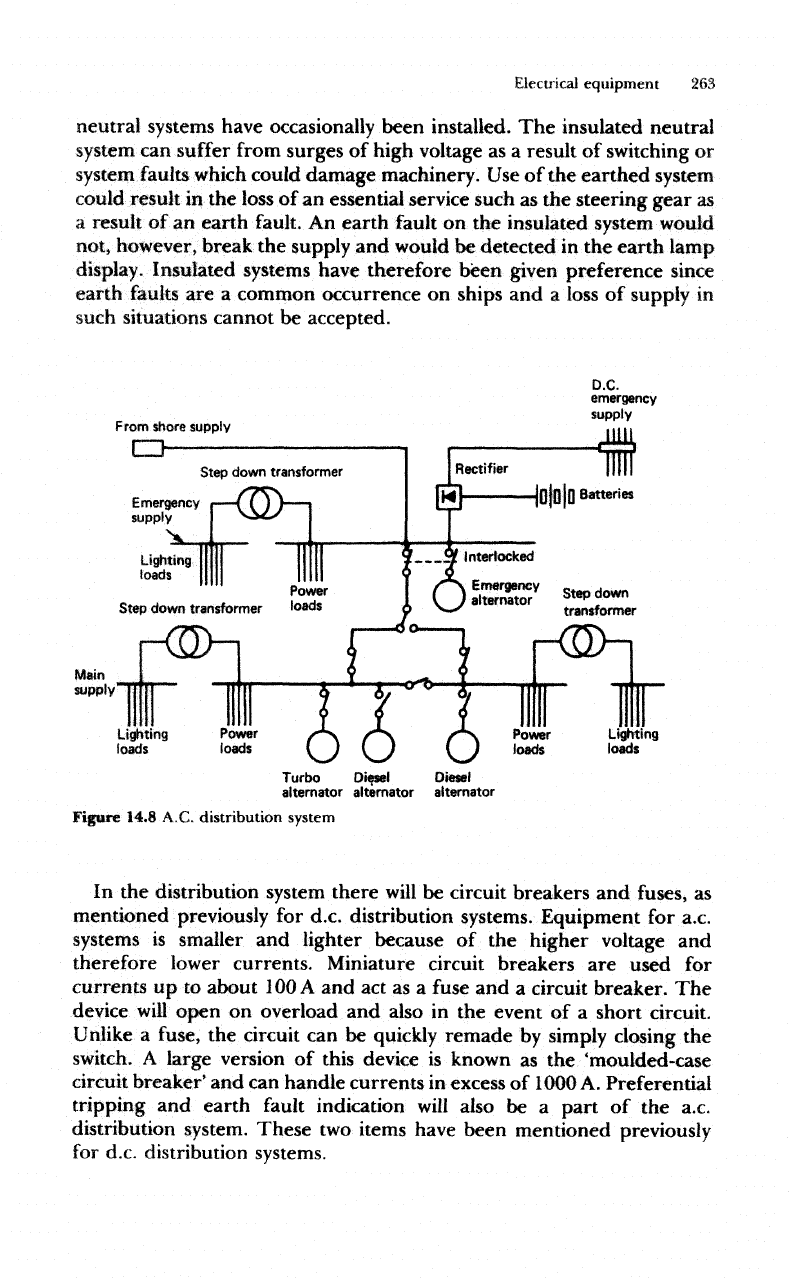
Electrical
equipment
263
neutral
systems have occasionally been installed.
The
insulated neutral
system
can
suffer
from
surges
of
high voltage
as a
result
of
switching
or
system
faults
which could damage machinery.
Use of the
earthed
system
could
result
in
the
loss
of an
essential service such
as the
steering gear
as
a
result
of
an
earth
fault.
An
earth
fault
on the
insulated system would
not,
however, break
the
supply
and
would
be
detected
in the
earth lamp
display.
Insulated systems have therefore been given preference since
earth
faults
are a
common occurrence
on
ships
and a
loss
of
supply
in
such
situations cannot
be
accepted.
From shore
supply
CD
Emergency
supply
Step
down
transformer
D.C.
emergency
supply
Main
suppty"TT
IT"""
Lighting
loads
Power
loads
Turbo
Diesel
alternator
alternator
Figure 14.8 A.C. distribution system
In the
distribution
system
there
will
be
circuit breakers
and
fuses,
as
mentioned previously
for
d.c. distribution systems. Equipment
for
a.c.
systems
is
smaller
and
lighter because
of the
higher voltage
and
therefore lower currents. Miniature circuit breakers
are
used
for
currents
up to
about
100 A and act as a
fuse
and a
circuit
breaker.
The
device
will
open
on
overload
and
also
in the
event
of a
short circuit.
Unlike
a
fuse,
the
circuit
can be
quickly
remade
by
simply
closing
the
switch.
A
large version
of
this device
is
known
as the
'moulded-case
circuit
breaker'
and can
handle currents
in
excess
of
1000
A.
Preferential
tripping
and
earth
fault
indication
will
also
be a
part
of the
a.c.
distribution system.
These
two
items have been mentioned previously
for
d.c.
distribution
systems.
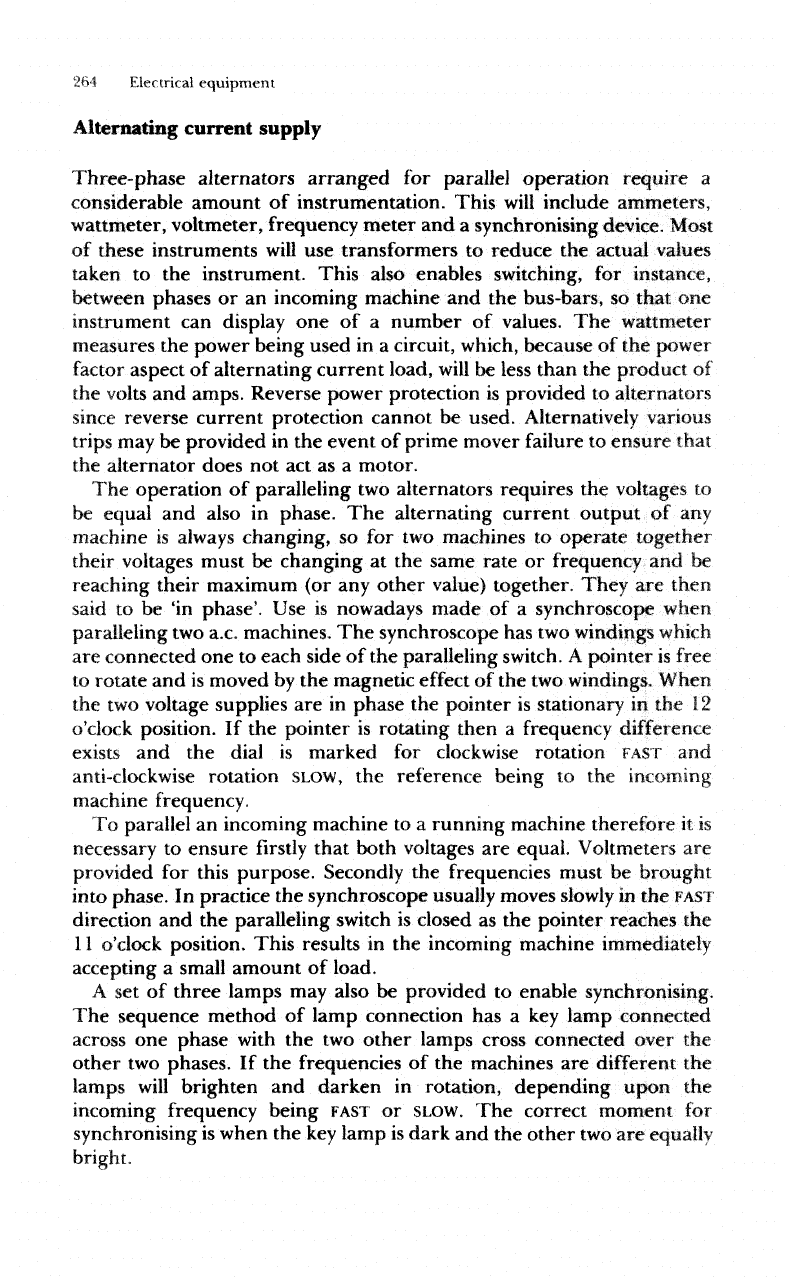
264
Electrical
equipment
Alternating current
supply
Three-phase
alternators
arranged
for
parallel
operation
require
a
considerable amount
of
instrumentation.
This
will
include ammeters,
wattmeter, voltmeter, frequency
meter
and a
synchronising device. Most
of
these instruments
will
use
transformers
to
reduce
the
actual
values
taken
to the
instrument.
This
also enables switching,
for
instance,
between phases
or an
incoming machine
and the
bus-bars,
so
that
one
instrument
can
display
one of a
number
of
values.
The
wattmeter
measures
the
power being used
in a
circuit,
which,
because
of the
power
factor
aspect
of
alternating current load,
will
be
less than
the
product
of
the
volts
and
amps. Reverse power protection
is
provided
to
alternators
since
reverse current protection cannot
be
used. Alternatively various
trips
may be
provided
in the
event
of
prime mover failure
to
ensure that
the
alternator does
not act as a
motor.
The
operation
of
paralleling
two
alternators requires
the
voltages
to
be
equal
and
also
in
phase.
The
alternating current output
of any
machine
is
always
changing,
so for two
machines
to
operate
together
their voltages must
be
changing
at the
same
rate
or
frequency
and be
reaching
their maximum
(or any
other value)
together.
They
are
then
said
to
be
'in
phase'.
Use is
nowadays made
of a
synchroscope when
paralleling
two
a.c.
machines.
The
synchroscope
has two
windings which
are
connected
one to
each
side
of the
paralleling switch.
A
pointer
is
free
to
rotate
and is
moved
by the
magnetic
effect
of the two
windings. When
the two
voltage supplies
are in
phase
the
pointer
is
stationary
in
the
12
o'clock position.
If the
pointer
is
rotating then
a
frequency
difference
exists
and the
dial
is
marked
for
clockwise rotation
FAST
and
anti-clockwise
rotation
SLOW,
the
reference being
to the
incoming
machine
frequency.
To
parallel
an
incoming machine
to a
running machine therefore
it is
necessary
to
ensure
firstly
that both voltages
are
equal
Voltmeters
are
provided
for
this purpose. Secondly
the
frequencies
must
be
brought
into
phase.
In
practice
the
synchroscope
usually moves slowly
in the
FAST
direction
and the
paralleling switch
is
closed
as the
pointer
reaches
the
11
o'clock position.
This
results
in the
incoming machine immediately
accepting
a
small amount
of
load.
A
set of
three
lamps
may
also
be
provided
to
enable synchronising.
The
sequence method
of
lamp
connection
has a key
lamp connected
across
one
phase
with
the two
other lamps cross connected over
the
other
two
phases.
If the
frequencies
of the
machines
are
different
the
lamps
will
brighten
and
darken
in
rotation, depending upon
the
incoming
frequency being
FAST
or
SLOW.
The
correct
moment
for
synchronising
is
when
the key
lamp
is
dark
and the
other
two are
equally
bright.
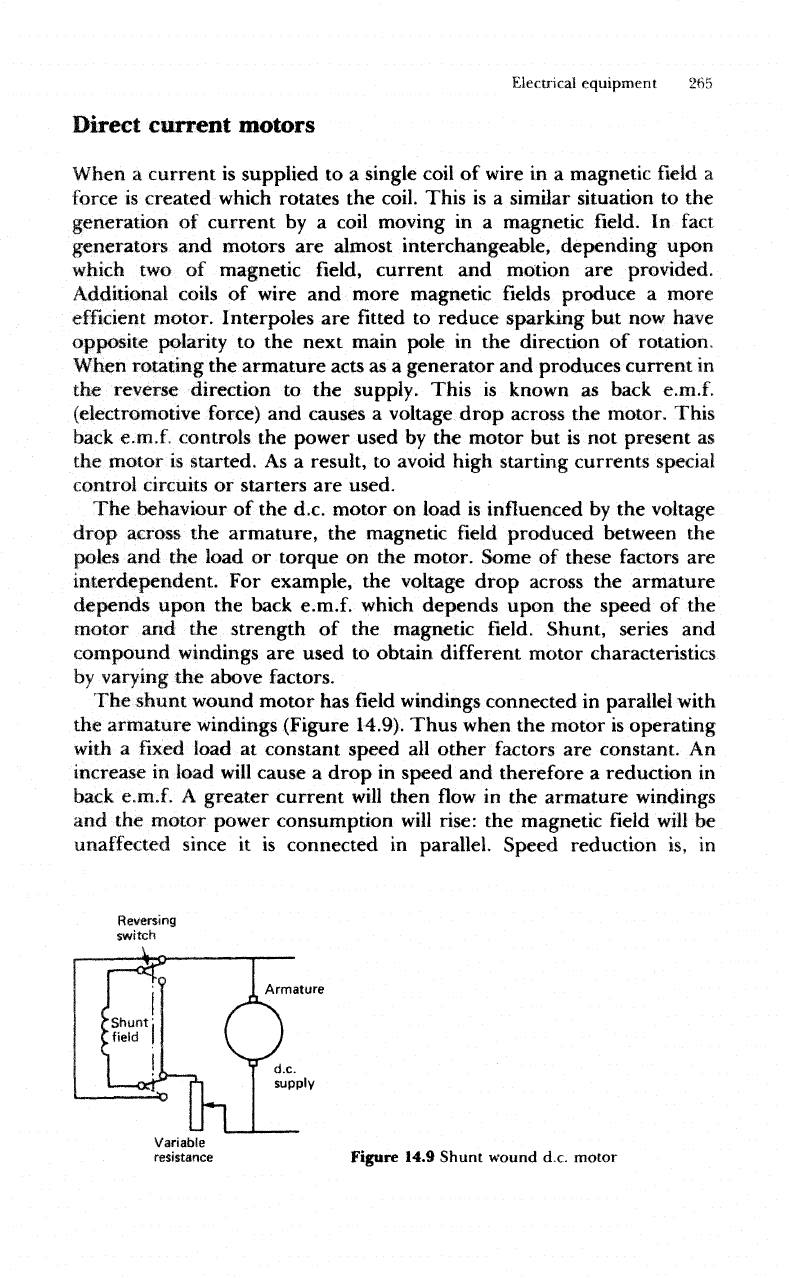
Electrical
equipment
265
Direct
current motors
When
a
current
is
supplied
to a
single coil
of
wire
in a
magnetic
field
a
force
is
created which rotates
the
coil. This
is a
similar situation
to the
generation
of
current
by a
coil
moving
in a
magnetic
field. In
fact
generators
and
motors
are
almost interchangeable, depending upon
which
two
of
magnetic
field,
current
and
motion
are
provided.
Additional
coils
of
wire
and
more magnetic
fields
produce
a
more
efficient
motor.
Interpoles
are fitted to
reduce sparking
but now
have
opposite polarity
to the
next main
pole
in the
direction
of
rotation,
When
rotating
the
armature acts
as a
generator
and
produces current
in
the
reverse direction
to the
supply. This
is
known
as
back
e.m.f.
(electromotive force)
and
causes
a
voltage
drop across
the
motor. This
back
e.m.f. controls
the
power used
by the
motor
but is not
present
as
the
motor
is
started.
As a
result,
to
avoid high starting currents special
control circuits
or
starters
are
used.
The
behaviour
of the
d.c. motor
on
load
is
influenced
by the
voltage
drop
across
the
armature,
the
magnetic
field
produced
between
the
poles
and the
load
or
torque
on the
motor. Some
of
these factors
are
interdependent.
For
example,
the
voltage
drop
across
the
armature
depends
upon
the
back e.m.f. which
depends
upon
the
speed
of the
motor
and the
strength
of the
magnetic
field.
Shunt, series
and
compound windings
are
used
to
obtain different motor characteristics
by
varying
the
above factors.
The
shunt wound motor
has field
windings
connected
in
parallel
with
the
armature
windings
(Figure 14.9). Thus when
the
motor
is
operating
with
a fixed
load
at
constant speed
all
other factors
are
constant.
An
increase
in
load
will
cause
a
drop
in
speed
and
therefore
a
reduction
in
back
e.m.f.
A
greater
current
will
then
flow in the
armature
windings
and the
motor power consumption
will
rise:
the
magnetic
field
will
be
unaffected
since
it is
connected
in
parallel. Speed reduction
is, in
Reversing
switch
Armature
Figure
14.9 Shunt wound d.c.
motor
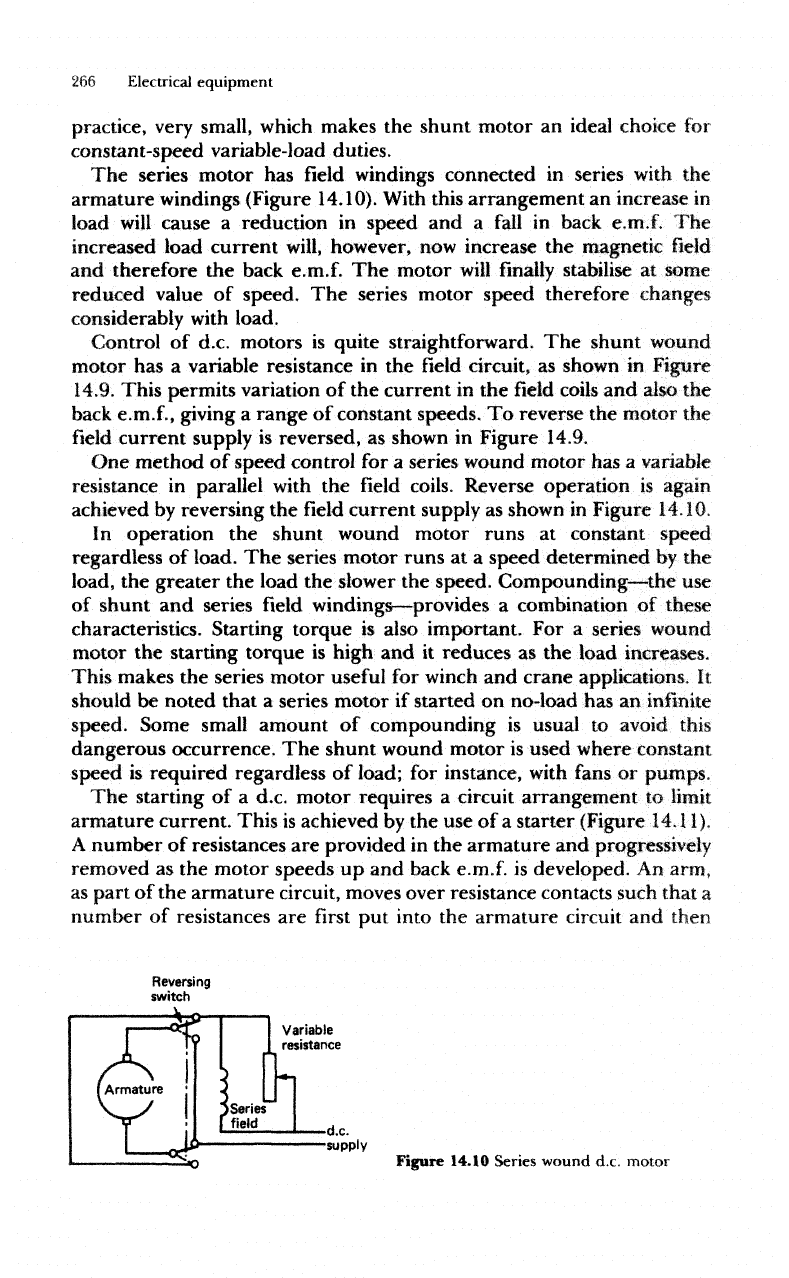
266
Electrical
equipment
practice,
very
small,
which
makes
the
shunt motor
an
ideal
choke
for
constant-speed
variable-load
duties.
The
series motor
has field
windings connected
in
series with
the
armature windings (Figure
14,10).
With
this arrangement
an
increase
in
load
will
cause
a
reduction
in
speed
and
a
fall
in
back
e.m.f.
The
increased load current
will,
however,
now
increase
the
magnetic
field
and
therefore
the
back e.m.f.
The
motor
will
finally
stabilise
at
some
reduced value
of
speed.
The
series motor speed therefore changes
considerably
with
load.
Control
of
d.c. motors
is
quite straightforward.
The
shunt wound
motor
has a
variable resistance
in the field
circuit,
as
shown
in
Figure
14.9.
This
permits variation
of the
current
in the field
coils
and
also
the
back
e.m.f.,
giving
a
range
of
constant speeds.
To
reverse
the
motor
the
field
current supply
is
reversed,
as
shown
in
Figure
14.9.
One
method
of
speed
control
for a
series
wound motor
has a
variable
resistance
in
parallel
with
the field
coils. Reverse operation
is
again
achieved
by
reversing
the field
current supply
as
shown
in
Figure
14.10.
In
operation
the
shunt wound motor runs
at
constant speed
regardless
of
load.
The
series
motor
runs
at a
speed
determined
by the
load,
the
greater
the
load
the
slower
the
speed.
Compounding—the
use
of
shunt
and
series
field
windings—provides
a
combination
of
these
characteristics. Starting torque
is
also important.
For a
series wound
motor
the
starting
torque
is
high
and it
reduces
as the
load increases.
This makes
the
series motor
useful
for
winch
and
crane applications.
It
should
be
noted that
a
series motor
if
started
on
no-load
has an
infinite
speed.
Some
small
amount
of
compounding
is
usual
to
avoid
this
dangerous occurrence.
The
shunt
wound
motor
is
used where constant
speed
is
required
regardless
of
load;
for
instance, with
fans
or
pumps.
The
starting
of a
d.c. motor requires
a
circuit arrangement
to
limit
armature
current.
This
is
achieved
by the use of a
starter (Figure
14.11).
A
number
of
resistances
are
provided
in the
armature
and
progressively
removed
as the
motor
speeds
up and
back e.m.f.
is
developed.
An
arm,
as
part
of the
armature
circuit,
moves over resistance contacts such that
a
number
of
resistances
are first put
into
the
armature
circuit
and
then
Figure
14,10
Series
wound d.c. motor
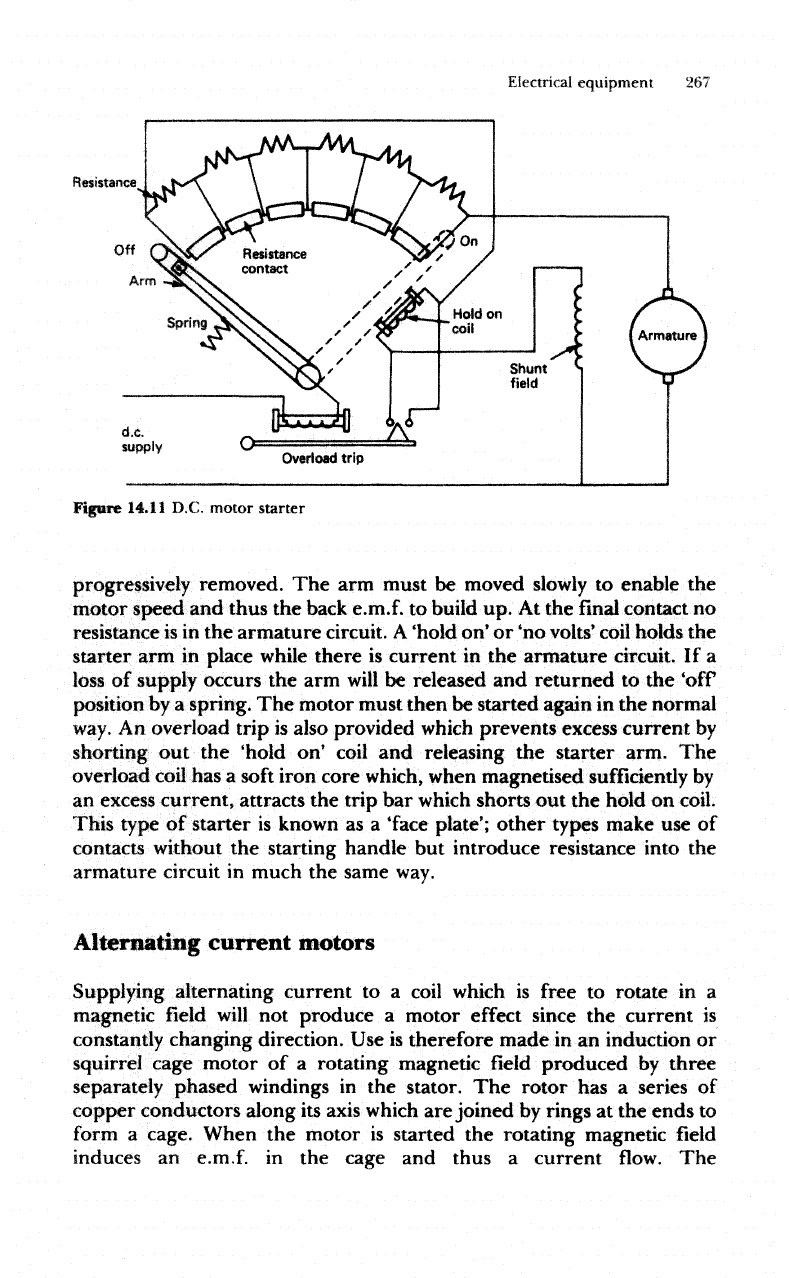
Electrical
equipment
267
Resistance
Figure
14.11
D.C.
motor starter
progressively
removed.
The arm
must
be
moved
slowly
to
enable
the
motor speed
and
thus
the
back e.m.f.
to
build
up. At the final
contact
no
resistance
is in the
armature circuit.
A
'hold
on'
or
'no
volts'
coil
holds
the
starter
arm in
place
while
there
is
current
in the
armature circuit.
If a
loss
of
supply
occurs
the arm
will
be
released
and
returned
to the
'off
position
by a
spring.
The
motor
must
then
be
started again
in the
normal
way.
An
overload trip
is
also provided
which
prevents
excess current
by
shorting
out the
'hold
on*
coil
and
releasing
the
starter
arm.
The
overload
coil
has a
soft
iron core
which,
when
magnetised
sufficiently
by
an
excess current, attracts
the
trip
bar
which
shorts
out the
hold
on
coil.
This type
of
starter
is
known
as a
'face
plate';
other types
make
use of
contacts
without
the
starting handle
but
introduce resistance
into
the
armature
circuit
in
much
the
same
way.
Alternating
current motors
Supplying
alternating current
to a
coil
which
is
free
to
rotate
in a
magnetic
field
will
not
produce
a
motor
effect
since
the
current
is
constantly
changing direction.
Use is
therefore made
in an
induction
or
squirrel cage motor
of a
rotating magnetic
field
produced
by
three
separately
phased
windings
in the
stator.
The
rotor
has a
series
of
copper conductors along
its
axis
which
are
joined
by
rings
at the
ends
to
form
a
cage.
When
the
motor
is
started
the
rotating magnetic
field
induces
an
e.m.f.
in the
cage
and
thus
a
current
flow.
The
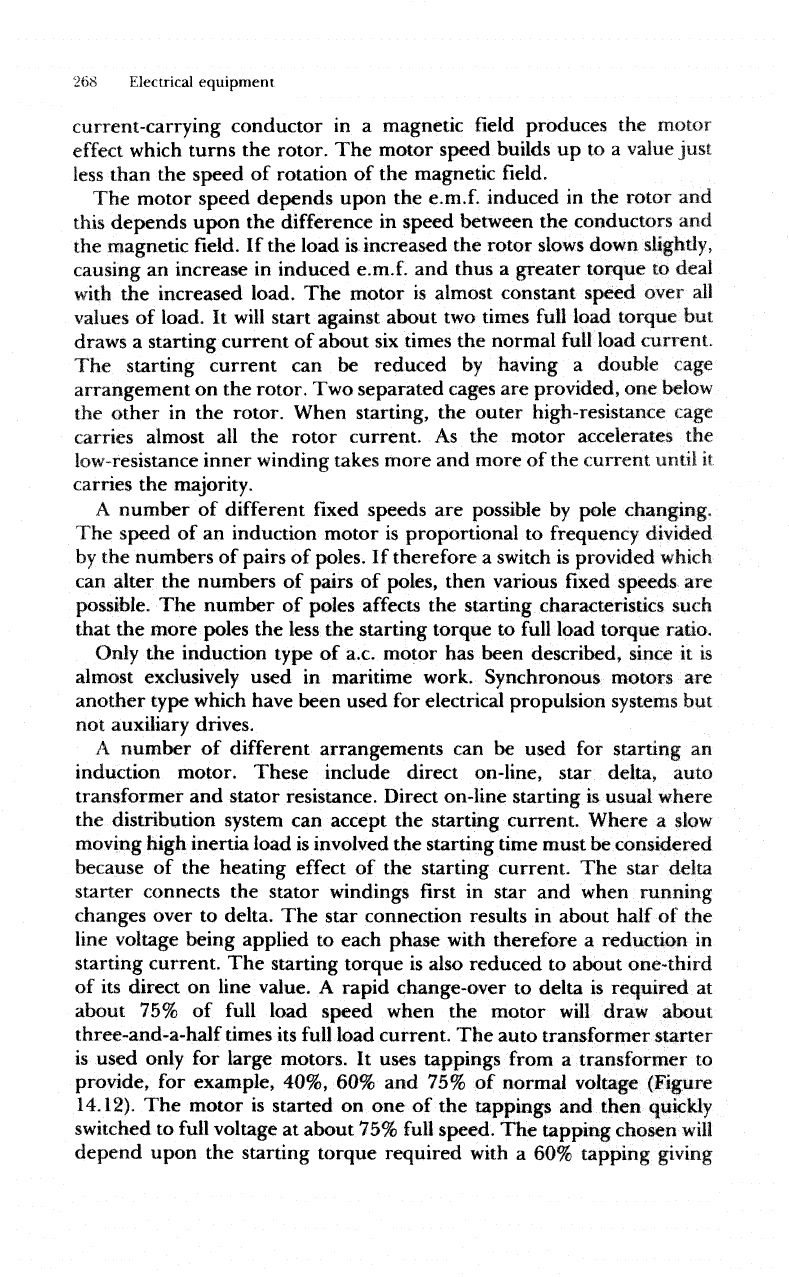
268
Electrical
equipment
current-carrying
conductor
in
a
magnetic
field
produces
the
motor
effect
which
turns
the
rotor.
The
motor speed builds
up to a
value
just
less
than
the
speed
of
rotation
of the
magnetic
field.
The
motor speed depends upon
the
e.m.f. induced
in the
rotor
and
this
depends upon
the
difference
in
speed between
the
conductors
and
the
magnetic
field. If the
load
is
increased
the
rotor
slows
down
slightly,
causing
an
increase
in
induced e.m.f.
and
thus
a
greater
torque
to
deal
with
the
increased load.
The
motor
is
almost constant
speed
over
all
values
of
load.
It
will
start against about
two
times
full
load torque
but
draws
a
starting current
of
about
six
times
the
normal
full
load current.
The
starting current
can be
reduced
by
having
a
double
cage
arrangement
on the
rotor.
Two
separated cages
are
provided,
one
below
the
other
in the
rotor.
When starting,
the
outer high-resistance cage
carries almost
all the
rotor current.
As the
motor accelerates
the
low-resistance
inner
winding
takes more
and
more
of the
current
until
it
carries
the
majority.
A
number
of
different
fixed
speeds
are
possible
by
pole changing.
The
speed
of an
induction motor
is
proportional
to
frequency divided
by
the
numbers
of
pairs
of
poles.
If
therefore
a
switch
is
provided
which
can
alter
the
numbers
of
pairs
of
poles, then various
fixed
speeds
are
possible.
The
number
of
poles
affects
the
starting characteristics such
that
the
more poles
the
less
the
starting torque
to
full
load torque ratio.
Only
the
induction type
of
a.c. motor
has
been described, since
it is
almost
exclusively used
in
maritime work.
Synchronous
motors
are
another type
which
have been used
for
electrical propulsion systems
but
not
auxiliary drives.
A
number
of
different
arrangements
can be
used
for
starting
an
induction
motor.
These
include direct on-line, star delta, auto
transformer
and
stator resistance. Direct on-line starting
is
usual where
the
distribution
system
can
accept
the
starting current. Where
a
slow
moving
high inertia
load
is
involved
the
starting
time must
be
considered
because
of the
heating
effect
of the
starting current.
The
star delta
starter connects
the
stator
windings
first in
star
and
when
running
changes
over
to
delta.
The
star connection results
in
about half
of the
line
voltage being applied
to
each phase
with
therefore
a
reduction
in
starting
current.
The
starting torque
is
also reduced
to
about one-third
of
its
direct
on
line value.
A
rapid change-over
to
delta
is
required
at
about
75% of
full
load speed when
the
motor
will
draw about
three-and-a-half times
its
full
load
current.
The
auto transformer starter
is
used
only
for
large
motors.
It
uses tappings
from
a
transformer
to
provide,
for
example,
40%,
60% and 75% of
normal voltage (Figure
14.12).
The
motor
is
started
on one of the
tappings
and
then
quickly
switched
to
full
voltage
at
about
75%
full
speed.
The
tapping chosen
will
depend upon
the
starting torque required
with
a 60%
tapping
giving

Electrical
equipment
269
Auto transformer
Motor
Running
Starting
Figure
14,12
Squirrel cage induction motor starting
about
70% of
full
load
torque.
A
smaller
percentage
tapping
will
give
a
smaller starting
torque
and
vice-versa.
The
stator
resistance starter
has a
resistance
in the
stator
circuit when
the
motor
is
started.
An
adjustable
timing
device
operates
to
short circuit
this
resistance when
the
motor
has
reached
a
particular
speed.
Modern electronic techniques enable a.c. induction motors
to be
used
in
speed-control
systems.
The
ship's supply,
which
may not be as
stable
in
voltage
or
frequency
as
that
ashore,
is first
rectified
to
provide
a
d.c,
supply. This
is
then used
as the
power supply
of an
oscillator using
high-power
electronic devices.
These
may be
thyristors (for powers
up to
1.5
M
W
or
more)
or
transistors (for powers
up to a few
tens
of
kilowatts).
The
high-power oscillator output
is
controlled
in
frequency
and
voltage
by
a
feedback system.
The
motor
speed
is
varied
by
changing
the
oscillator output frequency.
The
motor current necessary
to
obtain
the
desired
torque
(at
small angles
of
slip)
is
normally obtained
by
maintaining
the
voltage almost proportional
to
frequency.
Certain protective devices
are fitted in
the
motor circuit
to
protect
against faults such
as
single phasing, overload
or
undervoltage. Single
phasing occurs when
one
phase
in a
three-phase
circuit becomes open
circuited.
The
result
is
excessive currents
in ail the
windings
with,
in the
case
of
a
delta connected
stator
running
at
full
load,
one
winding taking
three
times
its
normal load current.
A
machine
which
is
running when
single phasing occurs
will
continue
to run but
with
an
unbalanced
distribution
of
current.
An
overload protection device
may not
trip
if the
motor
is
running
at
less than
full
load.
One
method
of
single phasing
protection utilises
a
temperature-sensitive device
which
isolates
the
machine
from
the
supply
at
some particular winding temperature.
Overload protection devices
are
also
fitted
and may be
separate
or
combined
with
the
single
phase
protection device. They must have
a
time
delay
fitted so
that operation
does
not
occur during
the
high
